Blue Heeler Getting Skinny Having Trouble Standing Up
Updated January 19, 2022
This isn't just a catalog of limping dogs. By knowing the leg problems that dogs get you have a better chance of preventing some, identifying others and taking them all seriously.
I've gone back through our records, found the top 20 with pictures. The list below is sorted into 'puppy', 'adult' and 'common' problems.Visit this page to see which problems happen in the front or back legs and how to tell which leg is sore.
Causes of Limping in Puppies
If a puppy starts limping, you may need to act fast to prevent a lifetime of problems. All these problems need to be identified and treated quickly in growing dogs. See also the common causes of limping discussed later and the cost of X-rays.
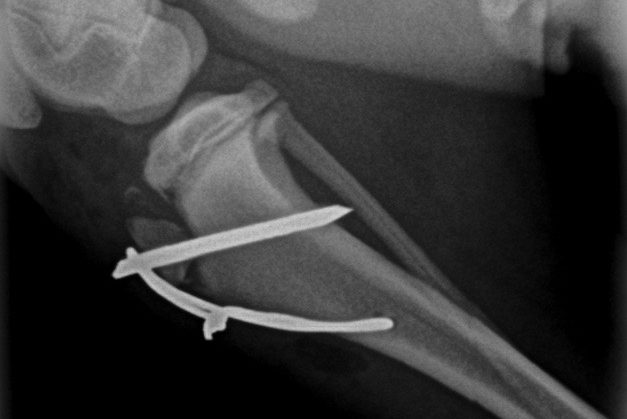
Fracture
Fractures in growing dogs are a lot like breaks in children. Most of the time they are either:
- Growth plate fractures, or
- Greenstick fractures
Growth plates are the dark bands you see in puppy xrays where new bone is forming, and are natural weak spots. The picture shows the repair of a tibial crest avulsion in the knee, a sort of growth plate fracture. The small piece of bone that's now fixed down was pulled off by the force of the patellar tendon.
Greenstick fractures are just like the name suggests- cracked but not fully broken, and heal very well if supported. The most common cause of both sorts of fractures is when puppies are dropped or fall from furniture.
Patellar Luxation
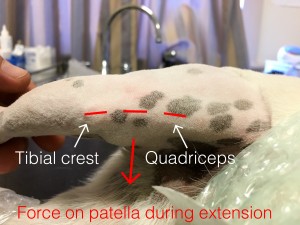
This is the most common cause of limping on and off in dogs, where a dog will walk normally, pull the leg up, then walk normally again. It's caused by the kneecap slipping out of the joint, and happens due to abnormalities in the growth of the leg. Patellar luxation usually starts before a dog turns one year old.
The picture shows my dog Loki just before his surgery. You can read more about patellar surgery here.
Hip Dysplasia
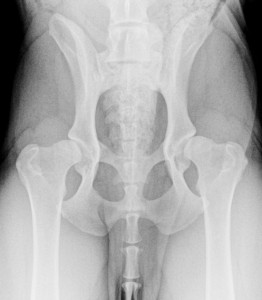
HD is still the most common and feared cause of a progressively worsening limp in a puppy. It is just as often seen as a 'quiet' puppy who sits a lot and appears reluctant to rise.
The xray shows the classic poor 'fit' between the ball and socket of the hips. If identified by 16 weeks of age hip dysplasia can be improved and sometimes even eliminated by a simple procedure called juvenile pelvic symphysiodesis.
Angular Limb Deformity
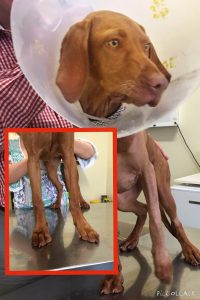
I see too many dogs whose owners didn't know the seriousness of a leg that starts turning out. This is an emergency and requires rapid intervention to avoid permanent deformity. It's caused by the fact that the forearm is made of two parallel bones: the radius and ulna. If one of the four growth plates is damaged, the other bone keeps growing and the leg starts to bow out.
Believe it or not, treatment requires us to cut the bone that stops growing so the other one can grow straight.
Elbow Dysplasia (FCP)
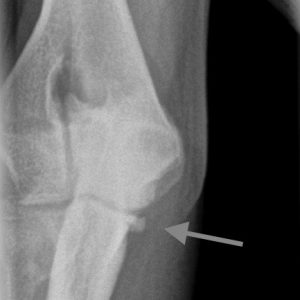
Fragmented Coronoid Process is the most common of the three conditions we call elbow dysplasia. The coronoid processes are tiny shelf-like projections easily fractured in puppies. These dogs need arthroscopic surgery to avoid a rapidly worsening elbow arthritis.
Elbow dysplasia is partly genetic and is screened for in susceptible breeds, usually large dogs. It is probably made worse by overfeeding and excessive exercise in the first 12 months of life.
Ununited Anconeal Process
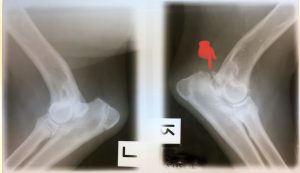
UAP is the second of the elbow dysplasia conditions (more than one can occur at a time, too). In UAP, a growth plate does not fuse with the adjacent bone and leaves a loose fragment. I removed this example surgically and the dog went on to live a normal life.
Osteochondrosis Dissecans
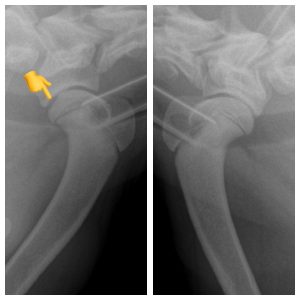
Although this is the third condition in the elbow dysplasia group, OCD also causes lameness and pain in other joints. The picture shows the subtle signs of osteochondrosis in the shoulder- can you see the damage? It's the flattened area on the head of the humerus.
OCD occurs when a piece of cartilage and bone flakes off the joint surface. The loose fragment then needs to be removed and the joint surface smoothed by a vet skilled in arthroscopy.
Panosteitis
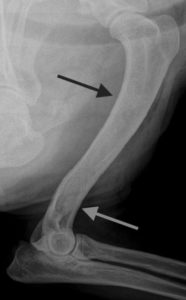
Honourable mention must also go to panosteitis, a common cause of lameness in dogs such as German Shepherds and other young, large-breeds.
Panosteitis is characterised by limping that changes from leg to leg, comes and goes, and responds to antiinflammatories. Its cause is poorly understood, but it usually disappears by 18 months of age.
X-rays of this condition, while necessary for diagnosis do not do it justice. The patchy densities arrowed are typical for an 'average' case.
Why Adult Dogs Limp
Once the body is fully grown, different leg problems become more common.
Arthritis
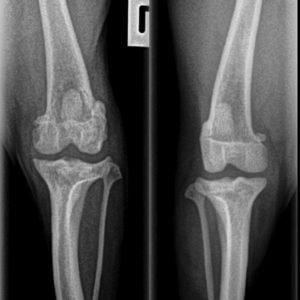
Osteoarthritis, also called degenerative joint disease, is the most common cause of limping after sleeping or rest. It becomes more common with age so that by 12 most dogs experience it. The picture shows an unlucky four-year-old dog's left knee, with the normal right knee for comparison. Read here how we treat arthritis in dogs.
Arthritis can also be caused by infection or auto-immune disease but in Adelaide, these are much less common.
Cruciate Ligament Rupture
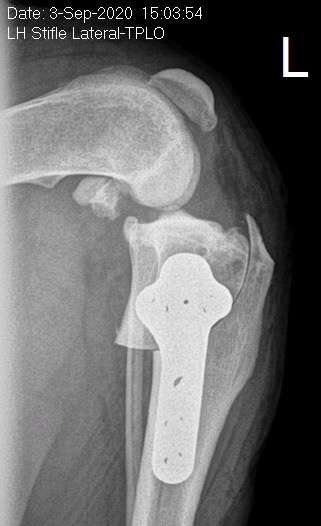
Probably the most common cause of a middle-aged dog who suddenly starts limping on a back leg is a ruptured cruciate ligament. The loss of the ligament causes the knee to become unstable and painful when the dog attempts to put weight on it. In nearly every case these dogs require surgery to return to full function.
Pictured is the TPLO procedure we perform on dogs over 15kg in weight. Read here about cruciate problems in dogs and the options for treatment.
Fractures
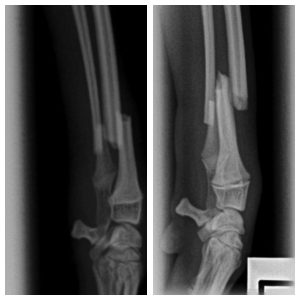
Once common, the advent of good fencing and dog control has made fractures a rare event in adult dogs. I looked back through our files and found these are now the common fractures:
- Toe fractures, usually easily managed by a supportive dressing.
- Metacarpal and metatarsal fractures, such as from a heavy object landing on the foot. These usually require surgical pinning.
- Italian Greyhounds with distal radius and ulna fractures. That's two in the picture above that we went on to repair surgically. The keen observer will note that the one on the right is actually a puppy with open growth plates.
Warning: we do still see occasional dogs hit by cars and it's now often caused by visitors or tradespeople leaving a gate open. I keep my dogs inside when workers are in our yard just for this reason.
Dislocations
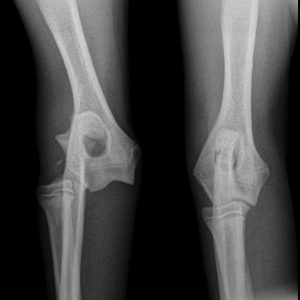
Dislocations occur when the parts of a joint become separated. It's important to realise this usually happens together with significant damage to the supporting ligaments.
Most dislocations are as a result of trauma, but some (especially of the shoulder) can happen due to congenital laxity (looseness) of the joint. The picture shows an elbow dislocation as a result of a high-speed collision between two dogs at a dog park. The second image is the same joint after Claire 'reduced' (fixed) the luxation under general anaesthetic.
Bone Cancer
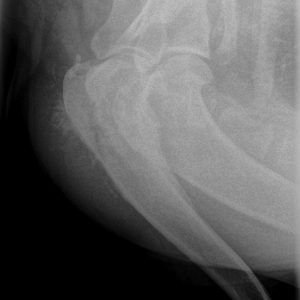
Tragically, not all limps are easily fixed. Bone cancer is especially common in large breed dogs from middle age and is often the main reason we will want to xray a gradually worsening lameness.
The picture shows the characteristic bone loss and new bone formation of an osteosarcoma in the humerus near the shoulder. Treatment of these dogs is primarily aimed at reducing pain levels, and improving quality of life, and occasionally chemotherapy for selected cases.
Read more about bone cancer in dogs here.
Neurological Causes
Diseases of the brain, spinal cord or nerves can look a lot like a limp. Many of these are life-threatening, like tick paralysis which is thankfully not endemic to South Australia. The video shows a dog with disc disease which I hope all dog owners will commit to memory.
You can read all about Ricky and the treatment of spinal disc rupture here. In the article are also listed the other similar neurological conditions.
Biceps Tendon Injury
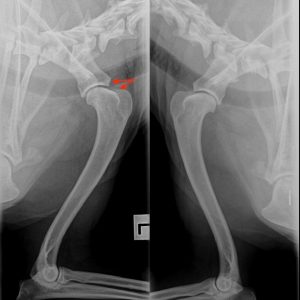
Biceps tears, avulsions or sprains are a surprisingly common cause of an ongoing limp in the foreleg. They heal badly and are prone to reinjury and relapse. The picture shows a reactive area where the biceps tendon attaches and focal calcified areas in the biceps groove.
Making the diagnosis allows us to set the correct level of exercise restriction for the right duration to allow healing to occur. This dog went on to full recovery with rest and anti-inflammatory treatment.
Other Common Causes Of Limping
Despite this section appearing last, it's where you'll find the majority of limps in dogs.
Skin Problems
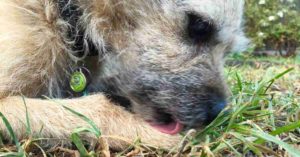
The skin between the toes and pads is very prone to dermatitis. This can become very sore and infected especially if it is licked. A feature of these dogs is that they are usually more uncomfortable on grass than smooth floors due to the leaves pricking the soft skin above the pads.
Read more here about why dogs lick their feet.
Nail Problems
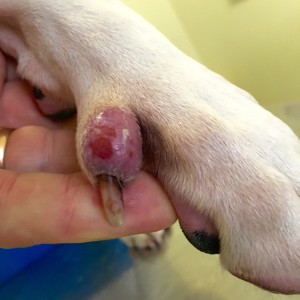
In order from most to least common, nail problems include:
- Broken or loose nails
- Nail bed infections
- Ingrown or over-long nails
- Tumours of the nailbed
- Auto-immune nail diseases
The picture shows an unusual fungal nailbed infection that required amputation to stop it spreading to the bone. Read more about nails and nail clipping here.
Pad Problems
Limping due to paw pads can be caused by:
- Overexercise causing loss of the hard layer of the pad
- Foreign material such as glass
- Diseases of the foot pads, often nutritional or metabolic
Foreign Bodies
The video you see here has been viewed 115,000 times so far on our Facebook. That makes us happy because the more that people know about preventing grass seed problems, the better for their dogs. A weeping sore between the toes during spring and summer is almost always caused by a migrating grass seed awn. At this stage, the dog will require an anaesthetic to have it removed but the video shows how easy it is to check dogs' feet after walks.
Sprains

Active dogs, especially when overweight, often suffer ongoing sprains in their forelegs. A particular culprit is the tennis ball, which I've written about before. The solution is reducing high impact exercise and controlling weight, plus judicious use of anti-inflammatories.
The picture shows a typical carpal (wrist) sprain, showing increased soft tissue density around the joint. Only an x-ray can distinguish this from a fracture.
Soft Tissue Injuries
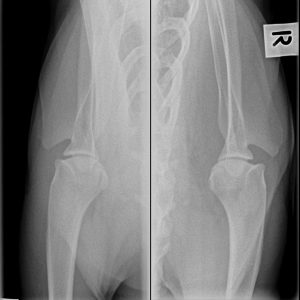
The advantage of xrays in most cases is that they neatly separate the dogs that need intervention from the dogs that can be managed conservatively. Until dogs learn to talk, we're going to need to use tests like these to know which dogs need help. For example, muscle tears don't show up on x-ray and that's fine.
The idea is simple. If a thorough radiographic study fails to identify any cause of the lameness, then 99 times out of 100 the dog will get better with rest and anti-inflammatories. However, the key word is 'thorough'. The x-rays above are a craniocaudal view of the shoulders of a dog, an exceedingly difficult area to do well. It was almost our last image in a long series, and thanks to the diagnosis the dog went on to make a full recovery.
Now it's your turn. Can you spot the difference and find the crack? Leave me a comment if it's driving you crazy.
NOTE: comments are now closed, but you should be able to find answers to all the common questions in the previous replies
Have something to add? Comments are welcome below and will appear within 24 hours.
By Andrew Spanner BVSc(Hons) MVetStud, a vet in Adelaide, Australia. The information provided here is not intended to be used as a substitute for going to the vet. If your pet is unwell, please seek veterinary attention.
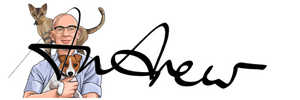
Source: https://www.walkervillevet.com.au/blog/why-dog-limping/
0 Response to "Blue Heeler Getting Skinny Having Trouble Standing Up"
Post a Comment